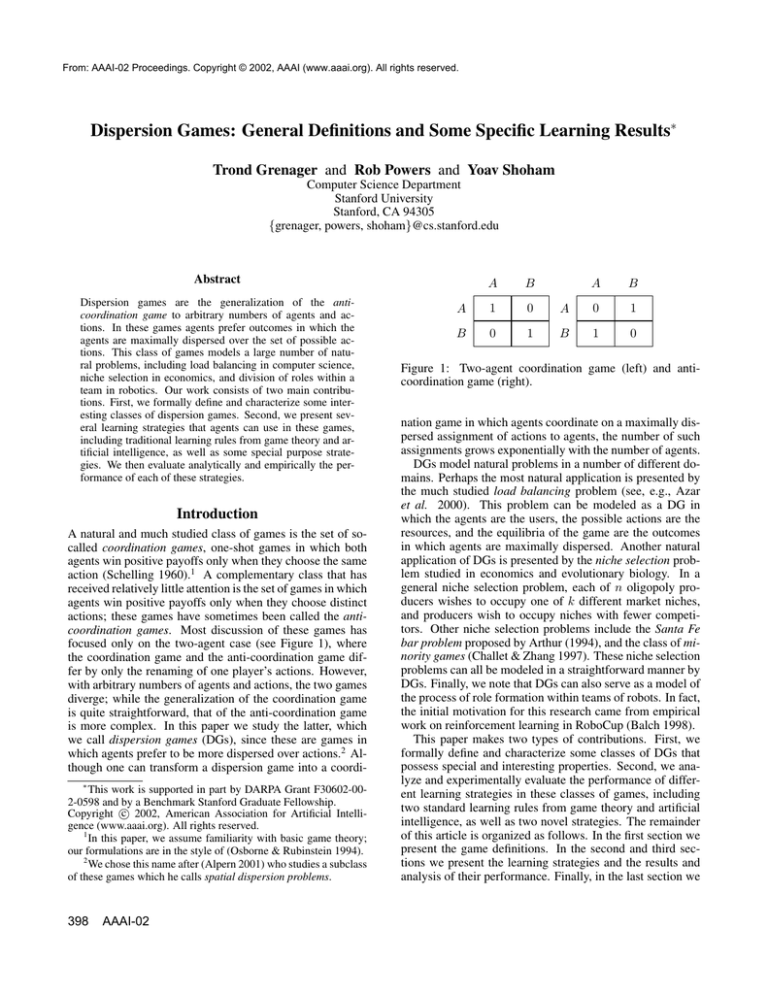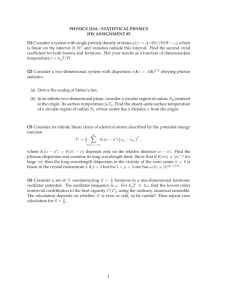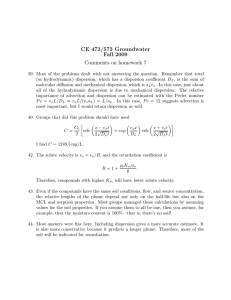
From: AAAI-02 Proceedings. Copyright © 2002, AAAI (www.aaai.org). All rights reserved.
Dispersion Games: General Definitions and Some Specific Learning Results∗
Trond Grenager and Rob Powers and Yoav Shoham
Computer Science Department
Stanford University
Stanford, CA 94305
{grenager, powers, shoham}@cs.stanford.edu
Abstract
Dispersion games are the generalization of the anticoordination game to arbitrary numbers of agents and actions. In these games agents prefer outcomes in which the
agents are maximally dispersed over the set of possible actions. This class of games models a large number of natural problems, including load balancing in computer science,
niche selection in economics, and division of roles within a
team in robotics. Our work consists of two main contributions. First, we formally define and characterize some interesting classes of dispersion games. Second, we present several learning strategies that agents can use in these games,
including traditional learning rules from game theory and artificial intelligence, as well as some special purpose strategies. We then evaluate analytically and empirically the performance of each of these strategies.
Introduction
A natural and much studied class of games is the set of socalled coordination games, one-shot games in which both
agents win positive payoffs only when they choose the same
action (Schelling 1960).1 A complementary class that has
received relatively little attention is the set of games in which
agents win positive payoffs only when they choose distinct
actions; these games have sometimes been called the anticoordination games. Most discussion of these games has
focused only on the two-agent case (see Figure 1), where
the coordination game and the anti-coordination game differ by only the renaming of one player’s actions. However,
with arbitrary numbers of agents and actions, the two games
diverge; while the generalization of the coordination game
is quite straightforward, that of the anti-coordination game
is more complex. In this paper we study the latter, which
we call dispersion games (DGs), since these are games in
which agents prefer to be more dispersed over actions.2 Although one can transform a dispersion game into a coordi∗
This work is supported in part by DARPA Grant F30602-002-0598 and by a Benchmark Stanford Graduate Fellowship.
c 2002, American Association for Artificial IntelliCopyright gence (www.aaai.org). All rights reserved.
1
In this paper, we assume familiarity with basic game theory;
our formulations are in the style of (Osborne & Rubinstein 1994).
2
We chose this name after (Alpern 2001) who studies a subclass
of these games which he calls spatial dispersion problems.
398
AAAI-02
A
B
A
1
0
B
0
1
A
B
A
0
1
B
1
0
Figure 1: Two-agent coordination game (left) and anticoordination game (right).
nation game in which agents coordinate on a maximally dispersed assignment of actions to agents, the number of such
assignments grows exponentially with the number of agents.
DGs model natural problems in a number of different domains. Perhaps the most natural application is presented by
the much studied load balancing problem (see, e.g., Azar
et al. 2000). This problem can be modeled as a DG in
which the agents are the users, the possible actions are the
resources, and the equilibria of the game are the outcomes
in which agents are maximally dispersed. Another natural
application of DGs is presented by the niche selection problem studied in economics and evolutionary biology. In a
general niche selection problem, each of n oligopoly producers wishes to occupy one of k different market niches,
and producers wish to occupy niches with fewer competitors. Other niche selection problems include the Santa Fe
bar problem proposed by Arthur (1994), and the class of minority games (Challet & Zhang 1997). These niche selection
problems can all be modeled in a straightforward manner by
DGs. Finally, we note that DGs can also serve as a model of
the process of role formation within teams of robots. In fact,
the initial motivation for this research came from empirical
work on reinforcement learning in RoboCup (Balch 1998).
This paper makes two types of contributions. First, we
formally define and characterize some classes of DGs that
possess special and interesting properties. Second, we analyze and experimentally evaluate the performance of different learning strategies in these classes of games, including
two standard learning rules from game theory and artificial
intelligence, as well as two novel strategies. The remainder
of this article is organized as follows. In the first section we
present the game definitions. In the second and third sections we present the learning strategies and the results and
analysis of their performance. Finally, in the last section we
discuss these findings and present ideas for future research.
Dispersion Game Definitions
In this section we begin by discussing some simple dispersion games, and work our way gradually to the most general
definitions. All of the DGs we define in this section are subclasses of the set of normal form games, which we define as
follows.
Definition 1 (CA, CP, CACP games) A normal form game
G is a tuple N, (Ai )i∈N , (i )i∈N , where
• N is a finite set of n agents,
• Ai is a finite set of actions available to agent i ∈ N , and
• i is the preference relation of agent i ∈ N , defined
on the set of outcomes O = An , that satisfies the von
Neumann-Morgenstern axioms.
A game G is a common action (CA) game if there exists a
set of actions A such that for all i ∈ N , Ai = A; we represent a CA game as N, A, (i )i∈N . Similarly, a game is
a common preference (CP) game if there exists a relation such that for all i ∈ N , i =; we represent a CP game as
N, (Ai )i∈N , . We denote a game that is both CA and CP
as CACP. We represent a CACP game as N, A, Note that we use the notation a1 , . . . , an to denote the
outcome in which agent 1 chooses action a1 , agent 2 chooses
action a2 , and so on. In a CA game where |A| = k, there
are k n total outcomes.
Common Preference Dispersion Games
Perhaps the simplest DG is that in which n agents independently and simultaneously choose from among n actions,
and the agents prefer only the outcomes in which they all
choose distinct actions. (This game was defined independently in (Alpern 2001).) We call these outcomes the maximal dispersion outcomes (MDOs).
This simple DG is highly constrained. It assumes that
the number of agents n is equal to the number of actions
k available to each agent. However, there are many problems in which k = n that we may wish to model with DGs.
When k > n the game is similar to the k = n game but
easier: there is a larger proportion of MDOs. When k < n
however, the situation is more complex: there are no outcomes in which all agents choose distinct actions. For this
reason, we will need a more general definition of an MDO.
In the definitions that follow, we use the notation noa to be
the number of agents selecting action a in outcome o.
Definition 2 (MDO) Given a CA game G, an outcome
o = a1 , . . . , ai , . . . , an of G is a maximal dispersion
outcome iff for all agents i ∈ N and for all outcomes
o = a1 , . . . , ai , . . . , an such that ai = ai , it is the case
that noai ≤ noa .
i
In other words, an MDO is an outcome in which no agent
can move to an action with fewer other agents. Note that
when the number of agents is less than or equal to the number of actions, an MDO allocates exactly one agent to each
action, as above.
Under this definition, the number of MDOs in a general
CA game with k actions is given by
k M DO(n, k) = n!
nmodk
n/knmodk n/k!k
.
When k = n this expression simplifies to n!, since there are
n! ways to allocate n agents to n actions.
The simple DG presented above also makes another
strong assumption. It assumes that an agent’s preference
over outcomes depends only on the overall configuration of
agents and actions in the outcome (such as the number of
agents that choose distinct actions), but not on the particular
identities of the agents or actions (such as the identities of
the actions that are chosen). We call these the assumptions
of agent symmetry and action symmetry. However, many
situations we might like to model are not agent and action
symmetric. For example, role formation on soccer teams is
not action symmetric. The identity of a particular field position in an outcome can affect the performance of the team: a
team with a goalie but no halfback would probably perform
better than one with a halfback but no goalie, all else being
equal. Robot soccer is also not necessarily agent symmetric.
If agent 1 is a better offensive than defensive player, then a
team may perform better if agent 1 is a forward instead of a
fullback, all else being equal. We use the following formal
definitions of symmetry.
Definition 3 (Agent Symmetry) A CA game G
=
N, A, (i )i∈N is agent symmetric iff for all outcomes
o = a1 , . . . , ai , . . . , an , and for all permutations
o = a1 , . . . , ai , . . . , an of o, for all i ∈ N , o i o and
o i o.
Definition 4 (Action Symmetry) A CA game G
=
N, A, (i )i∈N is action symmetric iff for all outcomes
o = a1 , . . . , ai , . . . , an and o = a1 , . . . , ai , . . . , an , if
there exists a one-to-one mapping f : A → A such that
for all i ∈ N , f (ai ) = ai , then for all i ∈ N , o i o and
o i o.
In fully symmetric games, agents cannot distinguish between outcomes with the same configuration of numbers of
agents choosing actions. Thus we use the abbreviated notation {n1 , . . . , nk } to refer to the set of outcomes in which
n1 agents choose some action, n2 agents choose a different
action, and so on. By convention, we order the actions from
most to least populated.
We are now ready to state the formal definition of a weak
DG that is well defined over the set of all CACP games,
including asymmetric games and games with arbitrary n, k.
Definition 5 (Weak DG) A CACP game G = N, A, is
a weak dispersion game iff the set of -maximal outcomes
of G is a subset of the set of MDOs of G.
This definition requires only that at least one of the MDOs
is a preferred outcome, and that none of the non-MDOs
is a preferred outcome. This definition is weak because it
places no constraints on the preference ordering for the nonmaximally-preferred outcomes.3 For this reason, we also
3
The reader may wonder why our definitions don’t require that
AAAI-02
399
state a strong definition. Before we can state the definition,
however, we will need the following dispersion relation.
Definition 6 () Given
two
outcomes
o
=
a1 , . . . , ai , . . . , an and o = a1 , . . . , ai , . . . , an ,
we have that o D o iff there exists a agent i ∈ N such
that ai = ai , and noai < noa , and for all other agents
i
j ∈ N, j = i, aj = aj . We let the dispersion relation be
the reflexive and transitive closure of D.
In other words, o is more dispersed than o if it is possible
to transform o into o by a sequence of steps, each of which
is a change of action by exactly one agent to an action with
fewer other agents. It is important to note that the dispersion
ordering is a structural property of any CACP game. The
dispersion relation over the set of outcomes forms a partially
ordered set (poset). Note that the set of MDOs is just the set
of -maximal elements of O.
There are many other measures that we could use instead
of the qualitative dispersion relation. Entropy is consistent
with, but stronger than our dispersion relation: if o o then
the entropy of o is higher than that of o , but the converse is
not necessarily true. We have chosen to base our definitions
on the weaker dispersion relation because it is the most general, and because it corresponds directly to a single agent’s
change of actions.
Using this dispersion relation, we can state the formal definition of strong DGs.
Definition 7 (Strong DG) A CACP game G = N, A, is a strong dispersion game iff for all outcomes o, o ∈ O, it
is the case that if o o but not o o, then o o but not
o o.
Recall that the preference relation forms a total ordering while the dispersion relation forms a partial ordering.
Thus this definition requires that o is strictly preferred to o
when o is strictly more dispersed than o .
If the strong definition has such nice properties, why
bother to state the weak definition at all? There are many
situations which have a dispersion quality but which cannot be modeled by games in the stronger class. Consider
the situation faced by Alice, Bob, and Charlie who are each
choosing among three possible roles in the founding of a
company: CEO, COO, and CFO. Because they will be compensated as a group, the situation can be modeled as a CP
game. However, suppose that Bob would be a terrible CEO.
Clearly, the agents would most prefer an outcome in which
each role is filled and Bob is not CEO; thus the game satisfies the weak definition. However, rather than have all roles
filled and Bob alone be CEO, they would prefer an outcome
in which Bob shares the CEO position with one of the other
agents (i.e., both Bob and another agent select the “CEO”
action), even though it leaves one of the other roles empty.
In other words, the preference relation conflicts with the dispersion ordering, and the game does not satisfy the strong
definition.
all MDOs are maximal outcomes. In fact, it is easy to verify that
this must be the case in a fully symmetric DG.
400
AAAI-02
Non-Common-Preference Dispersion Games
There are also several interesting classes of non-CP dispersion games we might like to model. Due to space considerations we will not define these classes formally, but instead
present a few motivating examples.
Consider again the load balancing application in which
each of n users simultaneously wishes to use one of k different resources. If the users all belong to a single organization, the interest of the organization can be well modeled
by a CP DG, since the productivity of the organization will
be highest if the users are as dispersed as possible among
the servers. However, the users’ preferences may be more
selfish: a user may prefer individually to use a resource with
the fewest possible other users, regardless of the welfare of
the rest of the group. Additionally, users’ preferences may
reflect some combination of individual and group welfare.
These problems may be modeled with the class of selfish
dispersion games.
Consider again the niche selection problem, in which each
of n oligopoly producers wishes to occupy one of k different
market niches. It may be the case that in addition to a general
preference for dispersal (presumably to avoid competition)
each producer has an exogenous preference for one of the
niches; these preferences may or may not be aligned. For
example, it may be that one of the market niches is larger
and thus preferred by all producers. Alternatively, a producer may have competencies that suit it well for a particular niche. Note that the two agent case can be modeled
by what one might call the anti-battle-of-the-sexes game in
which a man and his ex-wife both wish to attend one of two
parties, one of which is more desirable, but both prefer not
to encounter each other (the reader familiar with the original BoS game will appreciate the humor). These problems
can be modeled with the class of partial dispersion games,
in which agents’ preferences may align with either the dispersion ordering or with a set of exogenous preferences.
Learning Strategy Definitions
Now that we have defined a few interesting classes of dispersion games, let us consider the task of playing them in a
repeated game setting. There are two perspectives we may
adopt: that of the individual agent wishing to maximize his
individual welfare, and that of a system designer wishing to
implement a distributed algorithm for maximizing the group
welfare. In the present research, we adopt the latter.
Let us begin with the problem of finding an MDO as
quickly as possible in a weak CACP DG.4 Note that this
problem is trivial if implemented as a centralized algorithm.
The problem is also trivial if implemented as a distributed
algorithm in which agents are allowed unlimited communication. Thus we seek distributed algorithms that require
no explicit communication between agents. Each algorithm
takes the form of a set of identical learning rules for each
4
Note that any mixed strategy equilibrium outcome is necessarily preference dominated by the pure strategy MDOs. For this
reason, we henceforth disregard mixed strategy equilibria, and focus on the problem of finding one of the MDOs.
agent, each of which is a function mapping observed histories to distributions over actions.
Consider the most naive distributed algorithm. In each
round, each agent selects an action randomly from the uniform distribution, stopping only when the outcome is an
MDO. Note that this naive learning rule imposes very minimal information requirements on the agents: each agent
must be informed only whether the outcome is an MDO.
Unfortunately, the expected number of rounds until convergence to an MDO is
kn
.
M DO(n, k)
It is easy to see that for k = n the expected time is nn /n!,
which is exponential in n.
We began by evaluating traditional learning rules from
game theory and artificial intelligence. Game theory offers
a plethora of options; we looked for simplicity and intuitive
appropriateness. We considered both fictitious play (Brown
1951; Robinson 1951) and rational learning (Kalai & Lehrer
1993). Rational learning did not seem promising because of
its dependence on the strategy space and initial beliefs of the
agents. Thus we focused our attention on fictitious play.
In evaluating learning rules from artificial intelligence the
decision was more straightforward. Recently there has been
significant interest in the application of reinforcement learning to the problem of multi-agent system learning (Littman
1994; Claus & Boutilier 1998; Brafman & Tennenholtz
2000). We chose to implement and test the most common
reinforcement learning algorithm: Q-learning.
Finally, we developed a few special purpose strategies to
take advantage of the special structure of DGs.
Note that the different strategies we describe require
agents to have access to different amounts of information
about the outcome of each round as they play the game. At
one extreme, agents might need only a Boolean value signifying whether or not the group has reached an MDO (this
is all that is required for the naive strategy). At the other
extreme, agents might need complete information about the
outcome, including the action choices of each of the other
agents.
Fictitious Play Learning
Fictitious play is a learning rule in which an agent assumes
that each other agent is playing a fixed mixed strategy. The
fictitious play agent uses counts of the actions selected by
the other agents to estimate their mixed strategies and then
at each round selects the action that has the highest expected
value given these beliefs. Note that the fictitious play rule
places very high information requirements on the agents. In
order to update their beliefs, agents must have full knowledge of the outcome. Our implementation of fictitious play
includes a few minor modifications to the basic rule.
One modification stems from the well known fact that
agents using fictitious play may never converge to equilibrium play. Indeed our experiments show that fictitious play
agents in CP DGs often generate play that oscillates within
sets of outcomes, never reaching an MDO. This results from
the agents’ erroneous belief in the others’ use of a fixed
mixed strategy. To avoid this oscillation, we modify the
fictitious play rule with stochastic perturbations of agents’
beliefs as suggested by (Fudenberg & Levine 1998). In particular, we apply a uniform random variation of -1% to 1%
on the expected reward of each action before selecting the
agent’s best response.
The other modifications were necessary to make the
agents’ computation within each round tractable for large
numbers of agents. Calculating the expected value of each
possible action at each round requires time that is exponential in n. To avoid this, we store the history of play as counts
of observed outcomes rather than counts of each agents’ actions. Also, instead of maintaining the entire history of play,
we use a bounded memory of observed outcomes. The predicted joint mixed strategy of the other agents is then calculated by assuming the observed outcomes within memory
are an unbiased sample. 5
Reinforcement Learning
Reinforcement learning is a learning rule in which agents
learn a mapping from states to actions (Kaelbling, Littman,
& Moore 1996). We implemented the Q-learning algorithm
with a Boltzman exploration policy. In Q-learning, agents
learn the expected reward of performing an action in a given
state. Our implementation of Q-learning includes a few minor modifications to the basic algorithm.
It is well known that the performance of Q-learning is
extremely sensitive to a number of implementation details.
First, the choice of a state space for the agent’s Q-function
is critical. We chose to use only a single state, so that in
effect agents learn Q-values over actions only. Second, the
selection of initial Q-values and temperature is critical. We
found it best to set the initial Q-values to lie strictly within
the range of the highest possible payoff (i.e., being alone)
and the next highest (i.e., being with one other agent). We
chose to parameterize the Boltzman learning function with
an initial low temperature. These choices allow agents that
initially choose a non-conflicting action to have high probability of continuing to play this action, and allow those that
have collided with other agents to learn eventually the true
value of the action and successively choose other actions until they find an action that does not conflict.
In our implementation we chose to give the agents a selfish reward instead of the global common-preference reward.
The reward is a function of the number of other agents that
choose the same action, not of the degree of dispersion of
the group as a whole. This selfish reward has the advantage
of giving the agents a signal that is more closely tied to the
effects of their actions, while still being maximal for each
agent when the agents have reached an MDO.
Specialized Strategies
The first specialized strategy that we propose is the freeze
strategy. In the freeze strategy, an agent chooses actions
5
The reader might be concerned that this approximation
changes the convergence properties of the rule. Although this may
be the case in some settings, in our experiments with small n no
difference was observed from those using the full history.
AAAI-02
401
Definition 8 (Basic Simple Strategy) Given an outcome
o ∈ O, an agent using the basic simple strategy will
• If noa = 1, select action a with probability 1,
• Otherwise, select an action from the uniform distribution
over actions a ∈ A for which noa = 1.
We have extended the basic simple strategy to work in the
broader class of games for which n = k.
Definition 9 (Extended Simple Strategy) Given an outcome o ∈ O, an agent using the extended simple strategy
will
• If noa ≤ n/k, select action a with probability 1,
• Otherwise, select action a with probability
n/k
)
no
a
probability (1 −
which noa < n/k.
n/k
no
a
and with
Experimental Results
The learning rules and strategies described above differ significantly in the empirical time to converge. In Figure 2 we
plot as a function of n the convergence time of the learning rules in repeated symmetric weak DGs, averaged over
1000 trials. Table 1 summarizes the observed performance
of each strategy (as well as the information requirements of
AAAI-02
2
Naïve
FP
Freeze
BS&ES
1
RL
0
0
1
2
3
log(n)
Figure 2: Log-log plot of the empirical performance of different strategies in symmetric CACP dispersion games.
Learning
Rule
Naive
FP
RL
Freeze
BS & ES
Information
Requirements
Whether MDO
Full Information
Num. in Own Action
Num. in Own Action
Num. in All Actions
Avg. Rounds to
Converge (f (n))
EXP
EXP
POLY
LINEAR
LOG
Table 1: Applicability of strategies to various classes of
games with information requirements and estimated complexity class.
randomize over the actions a for
Unlike the basic strategy, the extended strategy does not
assign uniform probabilities to all actions that were not chosen by the correct number of agents. Consider agents reacting to the outcome {2, 2, 0, 0}. In this case each agent is
better off staying with probability 0.5 and jumping to each
of the empty slots with probability 0.25, than randomizing
uniformly over all four slots. The extended simple strategy
can actually be further improved by assigning non-uniform
probabilities to the actions a for which noa < n/k. We
have found empirically that the learning rule converges more
rapidly when agents place more probability on the actions
that have fewer other agents in them. Note that the extended simple strategy requires that agents know the number
of agents selecting each action in the round; the identity of
these agents is not required, however.
402
3
log(rounds)
randomly until the first time she is alone, at which point
she continues to replay that action indefinitely, regardless
of whether other agents choose the same action. It is easy to
see that this strategy is guaranteed to converge in the limit,
and that if it converges it will converge to an MDO. The
freeze strategy also has the benefit of imposing very minimal information requirements: it requires an agent to know
only how many agents chose the same action as she did in
the previous round.
An improvement on the freeze strategy is the basic simple
strategy, which was originally suggested by Alpern (2001).
In this strategy, each agent begins by randomly choosing an
action. Then, if no other agent chose the same action, she
chooses the same action in the next round. Otherwise, she
randomizes over the set of actions that were either unoccupied or selected by two or more agents. Note that the basic
simple strategy requires that agents know only which actions
had a single agent in them after each round.
each strategy). We discuss the performance of each of the
strategies in turn.
We begin with the learning rules. In our empirical tests
we found that stochastic fictitious play always converged to
an MDO. However, the number of rounds to converge was
on average exponential in n. In our empirical tests of the
reinforcement learning strategy we found that on average
play converges to an MDO in a number of rounds that is
linear in n. An interesting result is that for n = k, the algorithm didn’t converge to a unique selection of actions for
each agent, but rapidly adopted a set of mixed strategies for
the agents resulting in average payoffs close to the optimal
deterministic policy.
The specialized strategies generally exhibited better performance than the learning rules. Our empirical observations show that the number of rounds it takes for the freeze
strategy to converge to an MDO is linear in n. Our empirical
tests of both basic and extended simple strategies show that
on average, play converges to an MDO in a number of steps
that is logarithmic in the number of agents.6
6
For n > k certain ratios of n/k led consistently to superlogarithmic performance; slight modifications of the extended simple
strategy were able to achieve logarithmic performance.
Discussion
In this paper we have introduced the class of DGs and defined several important subclasses that display interesting
properties. We then investigated certain representative learning rules and tested their empirical behavior in DGs. In the
future, we intend to continue this research in two primary
directions.
First, we would like to further investigate some new types
of DGs. We gave examples above of two classes of non-CP
dispersion games that model common problems, but due to
space limitations we were not able to define and characterize
them in this paper. On a different note, we are also interested
in a possible generalization of DGs which models the allocation of some quantity associated with the agents, such as
skill or usage, to the different actions. We would like to define these classes of games formally, and explore learning
rules that can solve them efficiently.
Second, we would like to continue the research on learning in DGs that we have begun in this paper. The learning rules we evaluated above are an initial exploration, and
clearly many other learning techniques also deserve consideration. Additionally, we would like to complement the empirical work presented here with some analytical results. As
a preliminary result, we can prove the following loose upper
bound on the expected convergence time of the basic simple
strategy.
Proposition 1 In a repeated fully symmetric weak dispersion game with n agents and actions, in which all agents
use the basic simple strategy, the expected number of rounds
until convergence to an MDO is in O(n).
Informally, the proof is as follows. The probability that a
particular agent chooses an action alone is ((n − 1)/n)n−1 ,
and so the expected number of rounds until she is alone is
just (n/(n−1))n−1 . Because of the linearity of expectation,
the expected number of rounds for all agents to find themselves alone must be no more than nn /(n − 1)n−1 , which
is less than ne for all n > 1. Using similar techniques it is
possible to show a quadratic bound on the expected convergence time of the freeze strategy.
Unfortunately, our empirical results show that the basic
simple strategy converges in time that is logarithmic in n,
and that the freeze strategy converges in linear time. This
gap between our preliminary analysis and our empirical results begs future analytical work. Is it possible to show a
tighter upper bound, for these learning rules or for others?
Can we show a lower bound?
We would also like to better understand the optimality of
learning rules. It is possible in principal to derive the optimal reactive learning rule for any finite number of agents using dynamic programming. Note that the optimal strategies
obtained using this method are arbitrarily complex, however. For example, even upon reaching the simple outcome {2, 2, 0, 0}, an optimal reactive strategy for each agent
chooses the same action with probability 0.5118 (not 0.5, as
the extended simple strategy would dictate).
Dispersion games clearly play an important role in cooperative multiagent systems, and deserve much more discussion and scrutiny. We view the results of this paper as open-
ing the door to substantial additional work on this exciting
class of games.
References
Alpern, S. 2001. Spatial dispersion as a dynamic coordination problem. Technical report, The London School of
Economics.
Arthur, B. 1994. Inductive reasoning and bounded rationality. American Economic Association Papers 84:406–411.
Azar, Y.; Broder, A. Z.; Karlin, A. R.; and Upfal, E.
2000. Balanced allocations. SIAM Journal on Computing
29(1):180–200.
Balch, T. 1998. Behavioral diversity in learning robot
teams.
Brafman, R. I., and Tennenholtz, M. 2000. A near-optimal
polynomial time algorithm for learning in certain classes of
stochastic games. Artificial Intelligence 121(1-2):31–47.
Brown, G. 1951. Iterative solution of games by fictitious
play. In Activity Analysis of Production and Allocation.
New York: John Wiley and Sons.
Challet, D., and Zhang, Y. 1997. Emergence of cooperation and organization in an evolutionary game. Physica A
246:407.
Claus, C., and Boutilier, C. 1998. The dynamics of reinforcement learning in cooperative multiagent systems. In
AAAI/IAAI, 746–752.
Fudenberg, D., and Levine, D. K. 1998. The Theory of
Learning in Games. Cambridge, MA: MIT Press.
Kaelbling, L. P.; Littman, M. L.; and Moore, A. P. 1996.
Reinforcement learning: A survey. Journal of Artificial
Intelligence Research 4:237–285.
Kalai, E., and Lehrer, E. 1993. Rational learning leads to
nash equilibrium. Econometrica 61(5):1019–1045.
Littman, M. L. 1994. Markov games as a framework for
multi-agent reinforcement learning. In Proceedings of the
11th International Conference on Machine Learning (ML94), 157–163. New Brunswick, NJ: Morgan Kaufmann.
Osborne, M., and Rubinstein, A. 1994. A Course in Game
Theory. Cambridge, Massachusetts: MIT Press.
Robinson, J. 1951. An iterative method of solving a game.
Annals of Mathematics 54:298–301.
Schelling, T. 1960. The Strategy of Conflict. Cambridge,
Massachusetts: Harvard University Press.
AAAI-02
403








